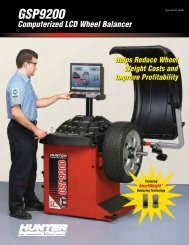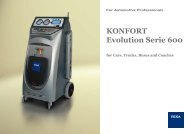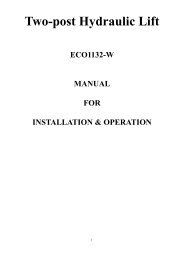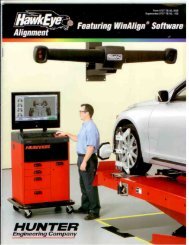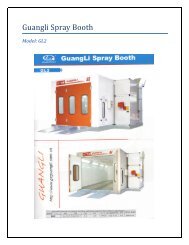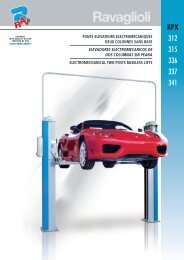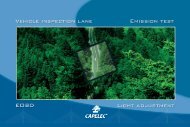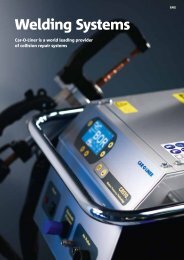View / Download - Madhus Garage Equipments
View / Download - Madhus Garage Equipments
View / Download - Madhus Garage Equipments
You also want an ePaper? Increase the reach of your titles
YUMPU automatically turns print PDFs into web optimized ePapers that Google loves.
Why do we need<br />
G5 Nitrogen?<br />
The following information is selected from internet:<br />
Sussex Police force, in the United Kingdom, carried out a roadside<br />
survey to check tyre pressures due to their concern with incorrectly<br />
inflated tyres. The check allowed a +/- 5psi tolerance against<br />
recommended handbook pressures.<br />
The results of the survey were that 73% of all cars checked had incorrect<br />
pressures<br />
Police also check the tyre pressures of every car involved in a road<br />
traffic accident in the UK. This data shows that 86% of vehicles involved<br />
in road traffic accidents have incorrect tyre pressures.<br />
Tyres that are under inflated by just 20% (4-6 psi) on average can add<br />
£2,600 to a fleet tyre bill that should be £10,000, a 26% increase in cost.<br />
According to police figures 73% of tyres checked were 5 psi out against<br />
handbook pressures<br />
It is estimated that under-inflation of 20% can cause fuel costs to rise by<br />
5%.<br />
Compressed air contains Water, Water vapour and Oxygen, which<br />
attacks the wheel rims and shortens the useful life of the rubber.
Why do all tyres lose pressure?<br />
The following information is selected from internet:<br />
Certain components namely Oxygen, water vapour and free water that<br />
are found in compressed air are prone to permeation through the tyre<br />
structure. This is not from faulty valves or leaky rims but a natural<br />
pressure loss across the tyre and into the atmosphere. Of these<br />
components, both water vapour and free water can enter the tyre in<br />
varying amounts even if identical tyres are inflated with the same gauge<br />
on the same day. Compressed air is not a specified gas and as such will<br />
always contain varying amounts of components that are not suitable for<br />
tyre these inflation.<br />
The benefits of Nitrogen Tyre<br />
Inflation<br />
The following information is selected from internet:<br />
Under inflated tyres create drag which increases tread wear, fuel costs<br />
and the risk of punctures as well as having a significant effect on a cars<br />
performance both in handling and cost. G5 produces a stable inflation<br />
mixture, that has improved pressure retention properties that will ensure<br />
tyres remain fully inflated for longer. By having your tyres at the correct<br />
pressures you will experience the following benefits:<br />
1. Better handling and road holding<br />
2. Reduces tread wear and increases tyre life by up to 25%<br />
3. Correct inflation pressures reduce puncture risk by up to 33%<br />
4. Reduced rolling resistance improves miles per gallon by 2%<br />
5. Improved pressure retention
Nitrogen Purge<br />
Function(N2P)<br />
More and more consumers are looking towards nitrogen for tyre inflation<br />
due to the added advantages<br />
that it can offer.These are temperature stability,reduced osmosis and<br />
reduced tyre pressure maintenance.<br />
These will all increase the safety for the driver of the vehicle.It also<br />
provides the financial benefits of increased tyre life and greater fuel<br />
economy.To increase the purity of nitrogen in the tyre the air must be<br />
removed.The N2P facility can be set between 0 and 9.This is the number<br />
of times the unit will purge the contents of the tyre and then re-inflate<br />
with the nitrogen supplied. The DPS can be set between<br />
4PSI/0.3bar/30kPa and 50% of the final target pressure.This is the first<br />
deflate lower limit setting.The unit will deflate the tyre down to the DPS<br />
setting,and then inflate to the final target pressure.If 1 N2P cycle<br />
wasset,then the cycle is now completed.If more than one N2P cycle was<br />
set,from the second N2P procedure, the unit will deflate the tyre to 50%<br />
of the final target pressure and refill to the final target pressure,the purge<br />
routine(deflate/inflate)is repeated according to the number of purge<br />
cycle set.<br />
If both OPS and N2P are set,then the unit will first over inflate to seat the<br />
bead,and then continue to purge he contents as required.<br />
Over Pressure<br />
Setting(OPS)<br />
When fitted,the bead of the new tyre must be seated on the wheel<br />
rim.This is done via inflating the tyre past the required pressure until the<br />
bead is in place.The pressure needs to then be reduced to the required<br />
pressure.Traditionally this is done manually and is therefore time<br />
consuming for the operator.The OPS function allows the operator to set<br />
the amount of over pressure between 0 and 2 bar/29psi/200kPa.The unit<br />
will then over inflate the tyre by the set amount before automatically<br />
deflating back to the final pressure required.
How the G5 PSA Nitrogen Generator<br />
Works<br />
The air is composed of 78% nitrogen gas, 21% oxygen and 1% other gas.<br />
The nitrogen inflator can get rid of the oxygen and the rest is nitrogen<br />
gas.<br />
There are two steel cylinders equipped with CMS in the nitrogen inflator.<br />
Just like sponge absorbing water, CMS can absorb the oxygen in the air<br />
without absorbing the nitrogen gas. (There are many pores on CMS<br />
surface and the molecular diameter of oxygen is smaller than that of the<br />
nitrogen. Therefore, the oxygen molecular can enter into the CMS<br />
surface and be absorbed, while the molecular diameter of nitrogen is<br />
relatively larger and cannot enter into the pores of CMS).<br />
When CMS absorb the oxygen to certain extent (saturation) and cannot<br />
absorb oxygen any more, the CMS in the nitrogen system will control the<br />
solenoid valve and exhaust the oxygen out.<br />
The diagrammatic sketch is as follows:<br />
O 2<br />
CMS<br />
AIR<br />
PRESSURE N 2<br />
AIR<br />
CMS<br />
Tank<br />
FILTER TANK TYRE<br />
O 2<br />
N 2
Manual Model Nitrogen Tyre<br />
Inflation System<br />
Model: T-1350<br />
T-1350 Main Features:<br />
■ 116PSI/8bar/800kPa<br />
■ 53L/min(1.9cfm)<br />
■ Suit for: Motorcycle, Car, Light Truck
T-1350 Technical Data Summary<br />
Dimensions(Height*Width*Depth) 1255mm*700mm*435mm<br />
Net Weight<br />
Gross Weight<br />
49.4”*27.6”*17.1”<br />
87kg/192lbs<br />
104kg/229lbs<br />
Packing Size(Height*Width*Depth) 1380mm*730mm*510mm<br />
Power Requirement<br />
Power Consumption<br />
54.3”*28.7”*20.1”<br />
100-240Vac 50/60HZ<br />
20W<br />
Operating Temperature Range -20℃/-4°F to 70℃ / 158°F<br />
Compressed Air Input Range 87-123PSI/6-8.5bar /600-850kPa<br />
Compressed Air Input Flow<br />
200L/min(7.2cfm)<br />
Nitrogen Purity 96-99%<br />
Nitrogen Output<br />
53L/min(1.9cfm)@116PSI/8bar/800kPa<br />
Absorption pressure<br />
Maximum Nitrogen Pressure in Tank 116PSI/8bar/800kPa<br />
T-1350 Specifications:<br />
1. Generates nitrogen from your compressed air<br />
2. 2 Pre-Filters<br />
3. 50L/13.2gal(us)internal nitrogen storage tank<br />
4. 1 Nos.*10m/32.8ft standard hose with 2 quick couplers to connect the<br />
unit and your inflation gun<br />
ourest@ourest.com www.ourest.com Fax: 0086-756-7260555



